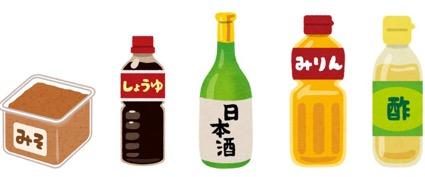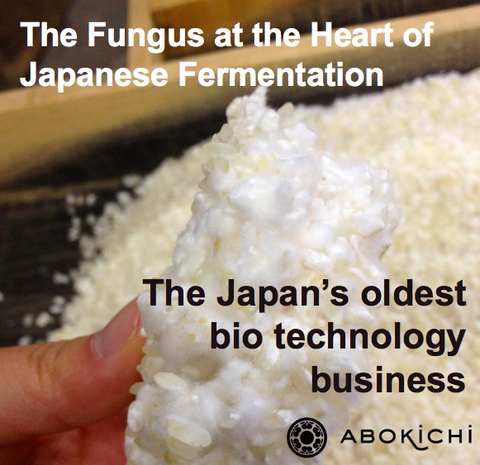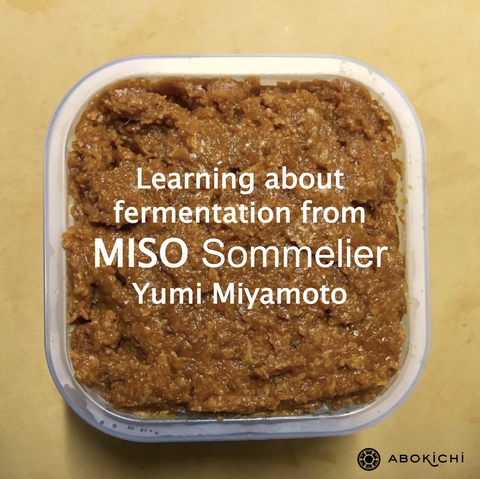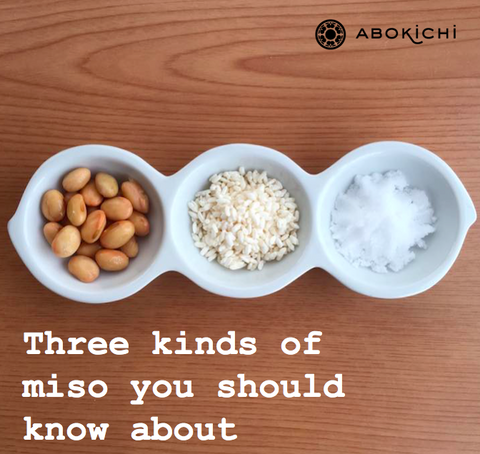Miso paste, soy sauce, mirin, vinegar, and sake are fundamental ingredients in any Japanese pantry, lending rich flavours to most of the dishes that Japan is so well known for; sushi, teriyaki, miso soup, and more. Amazingly, the production of these important ingredients relies on one vital, microscopic organism; koji-kin, otherwise known as Aspergillus Oryzae.
Aspergillus Oryzae, is a mould in the fungus family in the genus Aspergillus, used in fermentation. More well-known in the west, yeast is also a fungus used in the fermentation of beer, wine, and sourdough. It differs from Aspergillus Oryzae in that yeast is not a mould. Its products, and its story are also unique. Here we explain the history of koji-kin production in Japan, and its very important influence on the Japanese kitchen.
There are several varieties of Aspergillus moulds, all being categorized and getting their name based on their shape which resembles that of an aspergillum, the container used by priests in Catholic churches to sprinkle holy water.
The name Oryzae comes from the Latin word for rice, Orizae sativa. Aspergillus Oryzae grows on the heads of rice plants in East Asia. This is their optimal breeding ground. It can be found natural in the rice fields of Japan, China, and Korea, and harvested by hand by workers tromping through the soggy fields. In Japan, a unique way to cultivating the wild species developed around 800 years ago. Much like the corn, tomatoes, and melons and other fresh produce items found in the grocery stores of today were cultivated from less delicious and less productive wild varieties by our ancestors, Aspergillus Oryzae has been refined over generations by Japanese tradespeople.
How is Aspergillus Oryzae “farmed”?
While the fungal spores can be harvested in the wild, they can also be propagated on cooked rice, and other types of grains by providing them with the warm and moist environments they thrive in. By sprinkling the spores on the cooked grains, fungal filaments grow from the spores and root themselves into the steamed grains. These koji-kin inoculated grains are referred to generally as “koji.” Koji can be more accurately identified with names such as rice malt, barley koji, and bean koji, depending on the specific host grain. The various types of koji can then be used in the production of many delicious products.
Japanese Seasonings Related to Aspergillus Oryzae

Almost all of the seasonings used in Japanese cuisine are related to Aspergillus Oryzae. If there was no Aspergillus Oryzae, which gives rise to over 200 types of substances that act as bases for flavours and fragrances, Japanese cuisine (washoku) as we know it would not have been established. The Japanese koji, refined through careful cultivation, is unique to Japan.
CHECK OUT OUR MISO CHILI OIL CONDIMENT: OKAZU
The Historical Business of Aspergillus Oryzae Cultivation

Aspergillus Oryzae usually floats around in the air, and adheres to materials like rice straw. Foraging for Aspergillus Oryzae is a labour intensive undertaking, so fermentation brewing manufacturers purchase spores of Aspergillus Oryzae koji-kin in order to make their own koji as the first step in producing their products. The koji-kin business of cultivating and selling the fungus has been around for centuries.
At present, there are roughly 10 koji-kin dealers, called moyashi-ya, which sell Aspergillus Oryzae spores in Japan. Moyashi is the Japanese word for beansprouts, which the tiny koji-kin bear a striking resemblance to, when observed under a microscope. It is said that those 10 stores service almost all the roughly 4,000 businesses across Japan that use koji in their products, including miso makers, soy sauce makers, sake brewers and other alcohol producers, mirin manufacturers, vinegar brewers, and so on.
At the turn of the 13th century, a process was developed to harvest only pure koji spores from among a number of other fungi. This lead to widespread availability of this koji-kin, and a lot of illicitly home-brewed Japanese sake. In order to protect the koji and sake making industries, laws were established giving only those with government permission the right to propagate koji-kin. This led to much secrecy around the koji-kin “farming” process. Here’s the general idea:
When cooked starchy rice, a favourite of Aspergillus Oryzae, is left out at room temperature, many types of fungi are likely to propagate. Fortunately for everyone, it was discovered that the especially valuable Aspergillus Oryzae spores could be isolated despite the warmth and humidity of Japan which make it such a fungi-rich country.
The key is in ash, which had many uses in the lives of the people of the past. Ash was commonly used as soap due to its alkalinity and antibacterial properties. In a time before the soaps or synthetic detergents of the present, it was extremely useful in cleaning both tableware and clothing. Ash was also commonly used as a fertilizer; in the production of Japanese paper; in dyeing and textile making; in porcelain pottery production; and more. In Japan, there was such a huge demand that selling ash was very profitable, and even made some people rich.
As mentioned above, ash has an antibacterial effect, which was of immense usefulness in the lives of Japanese people of the past. Fungi that can inhibit such alkalinity are limited, koji-kin being one of them.

By sprinkling wood ash on the surface of steamed rice and leaving it at room temperature, the surface of the rice will become alkaline. Aspergillus Oryzae is unique in that it can live in alkalinity where other fungi would die. In addition to weeding out other funguses, wood ash contains potassium and phosphorus, which act as nutrition and actually aid the growth of Aspergillus Oryzae. Once the spores have sprouted, the sprouted spores and grains can be separated by using a sieve. These sprouts can now be used as seed-koji (moyashi).
It was about 800 years ago that the seed-koji business was born. It is even said that it was the first bio-industry in Japan. The development of the processes involved in the industrialization of koji production is pretty remarkable considering the limited chemistry and microbiology technology related to fermentation at the time.
Over time, just as pigs are descendants of wild boars, and dogs are descendants of wolves, it is said that Japanese people domesticated Aspergillus Oryzae harvested in the wild. There is also a theory that over the years, good fungus was continuously sorted out from wild Aspergillus Oryzae harvested in the wild, eventually becoming the modern Aspergillus Oryzae that is produced and sold in Japan today.
CHECK OUT OUR MISO CHILI OIL CONDIMENT: OKAZU
Just as individual human beings are unique in their inherited traits, with some being taller, or better at sports or math than others, for Aspergillus oryzae, there are subtle differences in its properties depending on the spore. Therefore, as there is a great influence on flavour, spores are chosen for their unique qualities depending on what sort of product is being made. In the case of sake, spores that produce enzymes that are better at breaking down starch are chosen; and in the case of miso or soy sauce, spores that produce enzymes that are better at breaking down protein are chosen.
Aspergillu Oryzae is so important to Japanese culture, that on October 12th, 2006, the Brewing Society of Japan named it the national fungus of Japan.
Just as Japan's national flower is the cherry blossom and its national bird is the Japanese pheasant, it was thought that a microorganism of so much importance to Japanese culture should be honoured as the national fungus. October 12th now stands as Aspergillu Oryzae Day.

Beginning hundreds of years ago, having been a fungus that was indispensable for Japanese fermentation brewing, Aspergillus Oryzae has come to be involved in almost all of the seasonings used in Japanese kitchens, including sake, mirin, vinegar, soy sauce, and miso. Japanese people, along with Aspergillus oryzae, cultivated the food culture of Japan, so if there was no Aspergillus oryzae, Japanese cuisine as we know it would never have been created.
Sources:
The Secret of Koji, Takeo Koizumi
There is Mystery in the Ashes, Takeo Koizumi
Koji, Eiji Ichishima
Japanese Cuisine – The Taste Mystery of a Thousand Years, NHK Special
*This article was edited by Jess Mantell.
RELATED ARTICLE
Basics About Fermentation
The Fungus At The Heart Of Japanese Fermentation, And Cuisine - Koji-Kin
Three Kinds Of Miso You Should Know About
The History Of Miso
The Power Of Miso

================================================
Yumi Miyamoto
Yumi was raised on her mother's homemade miso, inspiring a lifelong love of the stuff. Believing that mIso can forge love and bonding in families, she's been teaching folks how to make it since 2013. Yumi loves miso more than anything.
Currently, she is in charge of consumer education at Yuasa Soy Sauce Ltd, which has a long history of miso and soysauce making in Japan.
Yumi doesn't just teach adults, but also teaches elementary school kids how to make soy sauce, Kinzanji miso and tofu.
================================================




